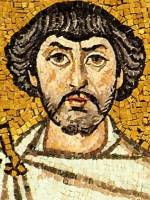|
Poslao: 01 Nov 2009 00:35
|
offline

- Pridružio: 21 Maj 2008
- Poruke: 15557
|
kljift ::Ja sam mislio da su Nijemci došli na ideju da smanje magnetni odraz koristeći se Cimeritom zbog protivtenkovskih mina sa magnetnim upaljačem samo ne vjerujem da su ih tada imali. Što se tiče tih prijanjajućih AT bombi teško mi je da shvatim njihovu primjenu, ipak se radi o neviđenoj akrobaciji koja od 1942 do 1945 nikom nije bila potrebna. Ali eto sad znamo zašto su dijelovi mnogih njemačkih vozila bili naborani.
Vidi par slika.
[Link mogu videti samo ulogovani korisnici]
Cimerit nije mogao da smanji odraz (niti postoji tako nešto).
Radio je na principu da odalji magnete od tela, pa da tako mina ne prianja na površinu i sama spada.
Što se tiče primene, čim su napravili dobre bombe koje mogu da se bacaju iz ruke, pa efikasne bacače, ovo je otišlo u istoriju, pa ga više nisu ni stavljali na tenkove.
|
|
|
|
|
Registruj se da bi učestvovao u diskusiji. Registrovanim korisnicima se NE prikazuju reklame unutar poruka.
|
|
|
Poslao: 01 Nov 2009 02:43
|
offline
- Veliki_Blek
- Zaslužni građanin

- Pridružio: 30 Dec 2008
- Poruke: 558
|
kljift :: Što se tiče tih prijanjajućih AT bombi teško mi je da shvatim njihovu primjenu, ipak se radi o neviđenoj akrobaciji koja od 1942 do 1945 nikom nije bila potrebna. Ali eto sad znamo zašto su dijelovi mnogih njemačkih vozila bili naborani.
Vec sam ranije pisao o njima u temi o rucnim kumulativnim protiv-oklopnim bombama. Ukratko prvo moras da pobijes neprijateljsku pesadiju da bi uopste mogao da pridjes tenku. Da bi svatio pravilnu taktiku njihove upotrebe odigraj Call of Duty2 posto u jednoj od misija imas zadatak da ih zalepis za Nemacke tenkove. Zbog toga sto lepljive bombe imaju teskoca da se zalepe kada se tenk isprlja zbog blata Nemci su ponekad namerno prljali svoje tenkove kako bi se zastitili od ovog oruzja.
Veliki_Blek ::
Sem rucnih PT bombi koje se aktiviraju udarnim upaljacem i koje se bacaju na oklopno vozilo postoji jos jedna vrsta PT bombi ko je igrao Call of Duty 2 zna o dobro o kojim bombama govorim. U pitanju su lepljive bombe koje koriste tempirani upaljac.
Nacin njihove upotrebe je bio veoma interesantan naime prilikom dejstva sa ovim tipom bombi od vojnika se ocekivalo da priđe tenku i jednostvano zalepi bombu na osetljivo mesto na tenku. Bomba bi se aktivirala tempiranim upaljacem posle 5 sekundi sto je davalo vojniku dovoljno vremena da se udalji od tenka pre njene eksplozije.
Kao i sva PT oruzja ni ovo nije bilo savrseno naime lepljiva bomba je ponekad imala problema da se zalepi za tenk. Interesantan je i eksploziv koji se koristio kod pojedinih lepljivih bombi naime u pitanju je bio nitroglicerin koji je veoma osetljiv na udar.

|
|
|
|
|
|
|
Poslao: 01 Nov 2009 12:04
|
offline
- Leonardo

- Moderator u penziji

- Pridružio: 17 Maj 2007
- Poruke: 13913
|
Evo na wikipediji odlicnih slika kad govorimo o nanosenju zimmerita.
[Link mogu videti samo ulogovani korisnici]
Evo jos jedne slike. jeste da crno-bela. Ali se nazire kako je nanet zimmerit.
[Link mogu videti samo ulogovani korisnici]
Galerija
[Link mogu videti samo ulogovani korisnici]
|
|
|
|
|
|
|
Poslao: 02 Nov 2009 17:45
|
offline
- kljift
- Legendarni građanin

- Pridružio: 11 Okt 2009
- Poruke: 7277
|
Jesu li Nijemci pravili za zaštitu oklopa još neke egzotične materijale poput cimerita?
|
|
|
|
|
|
|
|
|
Poslao: 05 Nov 2009 20:49
|
offline
- Leonardo

- Moderator u penziji

- Pridružio: 17 Maj 2007
- Poruke: 13913
|
Posto se tekstovi na wiki relativno lako menjaju, a tesko je predvideti kada ce se pojaviti neki "ekspert". Zato cu citirati jedan deo teksta koji se odnosi na Pantera II i verziju F (sa tyv. uskom kupolom).
Citat:Panther II
The early impetus for upgrading the Panther came from the concern of Hitler and others that the Panther lacked sufficient armor. Hitler had already insisted on an increase in armor to the Panther once, early in its design process in 1942. Discussions involving Hitler in January 1943 called for a Panther tank with further increased armor, initially referred to as Panther 2 (it became the Panther II after April 1943). This upgrade increased the glacis plate to 100 mm (3.9 in), the side armor to 60 mm (2.4 in), and the top armor to 30 mm (1.2 in). Production of the Panther 2 was slated to begin in September 1943.
In a meeting on February 10, 1943, further design changes were proposed - including changes to the steering gears and final drives. Another meeting on February 17, 1943 focused on sharing and standardizing parts between the next Tiger tank and the Panther 2, such as the transmission, roadwheels, and running gear. Additional meetings in February began to outline the various components for the Panther 2, including use of the 88 mm L/71 KwK 43 gun. In March 1943, MAN indicated that the first Panther 2 prototype would be completed by August 1943.
A number of engines were under consideration for use in the Panther II, among them the new Maybach HL 234 fuel-injected engine (900 hp operated by an 8-speed hydraulic transmission).
Thus, plans to replace the original Panther design with the Panther II were already underway before the first Panther had even seen combat.
From May to June 1943, further work on the Panther II ceased at the various manufacturers gearing up to produce the tank as the focus was shifted to expanding production of the original Panther tank. It is not clear if there was ever an official cancellation of the Panther II - this may have been because the Panther II upgrade pathway was started originally at the insistence of Hitler. The direction that the Panther II design was headed would not have been consistent with Germany's need for a mass-produced tank, which was the goal of the Reich Ministry of Armament and War Production.
One Panther II chassis was completed and eventually captured by the U.S.; it is now on display at the Patton Museum in Fort Knox. An Ausf G turret is mounted on this chassis.
Panther Ausf. F
After the Panther II project died, a more limited upgrade of the Panther was planned, centered around a re-designed turret. The Ausf F variant was slated for production in April 1945, but the war ended these plans.
The earliest known redesign of the Panther turret was dated November 7, 1943 and featured a narrow gun mantlet behind a 120 mm (4.7 in) thick turret front plate. Another design drawing by Rheinmettall dated March 1, 1944 reduced the width of the turret front even further; this was the Turm-Panther (Schmale Blende) (Panther with narrow gun mantlet).
Several experimental Schmalturm were built in 1944 with modified versions of the 75mm KwK 42 L/70, which were given the designation of KwK 44/1. A few were captured and shipped back to the U.S. and Britain.
The Schmalturm had a much narrower front face of 120 mm (4.7 in) armor sloped at 20 degrees; side turret armor was increased to 60 mm (2.4 in) from 45 mm (1.8 in); roof turret armor increased to 40 mm (1.6 in) from 16 mm (0.63 in); and a bell shaped gun mantlet similar to that of the Tiger II was used. This increased armor protection also had a slight weight saving due to the overall smaller size of the turret.
The Panther Ausf F would have had the Schmalturm, with its better ballistic protection, and an extended front hull roof which was slightly thicker. The Ausf F's Schmalturm was to have a built-in stereoscopic rangefinder and lower weight than the original Panther turrets. A number of Ausf F hulls were built at Daimler-Benz and Ruhrstahl-Hattingen steelworks; however there is no evidence that any completed Ausf F saw service before the end of the war.
Proposals to equip the Schmalturm with the 88mm KwK 43 L/71 were made from January through March 1945. These would have likely equipped future German tanks but none were built, as the war ended.
[Link mogu videti samo ulogovani korisnici]
Kao sto rekoh wiki nije konstanta. Tako da lepe slike dolaze i prolaze. Nadajmo se da ostaju sto duze sa nama. Ovde cu postaviti jedan broj tih slika uz komentare.

April/Maj 1943.

Istocni front '44.

Opravka transmisije.


Panterova kupola nije retko koricena na ovaj nacin. Negde u Italiji.

Proizvodna linija.

Komandni Panter verzija A. Großdeutschland divizija u juznoj Ukrajini '44.

Rumunija, okolina Lasi '44.


Panter unisten tokom Ardenske bitke.
Preuzeo sa: [Link mogu videti samo ulogovani korisnici]
|
|
|
|
|
|
|
|
|
Poslao: 19 Okt 2011 16:25
|
offline

- Pridružio: 21 Maj 2008
- Poruke: 15557
|
После рата, свега неколико земаља у Европи је користили заробљене Пантере.
Французи су са 50 комада били највећи корисник.
Ево њиховог извештаја о Пантеру из 1947, који је објављен у књизи Panther & Its Variants
Citat:French experience with the Panther were put to paper in the report
"Le Panther 1947", published by the Ministre de la Guerre, Section
Technique de L'Armee, Groupement Auto-Char,
— The turret traverse drive is not strong enough to either turn the turret
or hold it in place when the Panther is on an incline of more than 20
degrees. The Panther is therefore not capable of firing when driving
cross-country.
— Elevating the gun is normally simple, but made difficult if the
stabilizer — operated by compressed nitrogen — has lost pressure.
— The commander's cupola with its 7 periscopes provides a nearly
perfect all-round visibility. Periscopes damaged by shells can be replaced
very quickly.
— A scissors periscope with large magnification power was affixed to a
bracket in the commander's cupola.
— Aside from his periscope gunsight (which is excellent), the gunner has
no other type of observation device. He is therefore practically blind —
one of the greatest shortcomings of the Panther.
— The gunsight with two magnification stages is remarkably clear and
has its field of view clear in the center. The gunsight enables observation
of a target and shells out to over 3000 meters.
— No type of hollow charge ammunition is planned for the Panther.
— The HE shell can be fired with a delay of 0.15 seconds.
— The PzGr 40 had better penetration out to 1500 meters than the PzGr
39, but then its trajectory drops off considerably.
— During rapid rate of fire it is not uncommon to be forced to break off
firing when the recoil of the gun has reached its permissible limit (cease
fire).
— A rate of fire of 20 rounds per minute is only permitted in exceptional
cases when circumstances so dictate.
— When firing off a round the chassis demonstrates no unfavorable
reaction, regardless of what position the turret is in.
— Once the commander has located a target, it takes between 20 and 30
seconds until the gunner can open fire. This data, which is significantly
greater than that of the Sherman, stems from the absence of a periscope
for the gunner.
— The fatigue life of the mechanical parts was designed for 5000 km.
The wear on many parts is greater than expected. Track and running
gear have a life of 2000 to 3000 km. Tracks break very rarely, even on
rocky terrain. The bogie wheels, however, can become deformed when
driven hard.
— The parts of the power train (with the exception of the final drive)
meet the planned fatigue life. The replacement of a transmission
requires less than a day.
— On the other hand, the engine was not operable over 1500 km. The
average engine life amounted to 1000 km. Engine replacement ac-
complished in 8 hours by an Unteroffiaer (mechanic by occupation) and
8 men with the aid of a tripod beam crane or a Bergepanther. Main gun
can be replaced using the same equipment within a few hours. The
German maintenance units performed their work remarkably well
— As a result, the Panther is in no way a strategic tank. The Germans did
not hesitate to economically increase the engine life by loading the tank
onto railcars — even for very short distances (25 km).
— The truly weak spot of the Panther is its final drive, which is of too
weak a design and has an average fatigue life of only 150 km.
— Half of the abandoned Panthers found in Normandy in 1944 showed
evidence of breaks in the final drive.
— In order to prevent these breaks it is recommended that the following
points be closely observed: when driving downhill and in reverse as well
as on uneven terrain to be particularly careful when shifting to a lower
gear. In addition, a Panther should never be towed without uncoupling
the final drive previously. Finally, under no circumstances should both
steering levers be operated simultaneously — regardless of the situation.
— A hollow charge round — regardless of what type — will penetrate
armor plating equivalent to its own caliber. It is therefore necessary to
use a 105 mm round or, at the very least, an 88 mm round to penetrate the
glacis plate of the Panther (Munsingen, 1946)
- A smoke grenade thrown onto the reardeckor the vent openings of the
engine will start a fire.
- The running gear is sensitive to HE shells. Calibers 105 mm and
greater can render the vehicle immobile (Rammersmatt, 8 December
1944).
- Fragmentation shells or 75 mm rounds which strike in the same spot
on the front plate can penetrate it or cause the weld seams to break
(Munsingen, 1946).
- No place of the Panther is so armored that it can withstand a
"Panzerfaust" or "Panzerschreck."
- In all cases, the great range of the gun should be exploited to the
fullest. Fire can commence at a range of 2000 meters with considerable
accuracy. The majority of hits were accomplished at a range of 1400 to
2000 meters. The ammunition expenditure was relatively low; on the
average the fourth or fifth shot found its mark, even when using HE
shells.
Without a doubt, the Panther was a fully combat-capable tank in 1943
which for its day exhibited remarkable performance in regard to its
armament and armor.
Yet even German documents showed that it had considerable weak-
nesses:
- Inadequate for strategic mobility due to the short fatigue life of its
engine, which lay between six and seven times the vehicle's range. The
Panther cannot cover large distances and must restrict itself to short
distances.
- Deficiency in mobility due to an inadequate steering mechanism,
which had a very high breakdown rate.
- Operations required generally specialized personnel: in the Wehr-
macht an officeror Oberfeldwebel as tank commander, Unteroffiziers as
gunner and driver.
Once the Germans no longer had any experienced tank crews, it was
apparent that the Panthers were no longer employed operationally or
were abandoned because of mechanical breakdowns.
|
|
|
|
|
|
|
Poslao: 19 Okt 2011 21:22
|
offline
- Leonardo

- Moderator u penziji

- Pridružio: 17 Maj 2007
- Poruke: 13913
|
Potvrđuje tvrdnju poslednjih živih nemačkih tenkista koji su tvrdili da bi iz 4 pokušaja pogodili metu na udaljenosti do 2km.
|
|
|
|
|
|
|
Poslao: 20 Okt 2011 16:46
|
offline
- Pridružio: 13 Sep 2011
- Poruke: 1061
|
Napisano: 20 Okt 2011 16:41
Panter je bio tenk sa moćnim topom i moćnim oklopom, a pokretljivost mu nije bila jača strana. Ako ga uprkos masi od 45t svrstamo u srednje tenkove onda je to naj oklopljeniji srednji tenk sa naj jačim topom u 2.SR (ne računam savezničke tenkove koji su se u malom broju pojavili na samom kraju rata). Pokretljivost je veoma bitna za srednje tenkove, npr. za razvoj operativnog uspjeha, za izvođenje brzih protivudara, za obilaženje jahih PT rejona itd. Pokretljivost može biti: taktička, operativna i strategiska. Taktička podrazumijeva: brzinu kretanja, prohodnost, okretljivost, akcioni radijus itd. i odnosi se na kretanje tenka u borbi. Operativna se odnosi na sposobnost izvršenja marševa i obuhvata: brzinu kretanja, akcioni radius, potrebe za osnovnim održavanjem, potrošnju goriva itd. Značajnu ulogu igra i masa tenka zbog mogućnosti korištenja putne mreže, posebno mostova. Strategiska se odnosi na mogućnost transporta tenkova sa jednog vojišta na drugo i podrezumijeva pogodnost tenka za prevoz željeznicom, vučnim vozom, brodom i u današnje vrijeme i vazdušnim putem. Upravo zbog pokretljivosti T-34/85 je bio bolji srednji tenk od Pantera, uprkos slabijem topu i oklopu. U martu 1945. pojavio se prototip tenka T-54, koji je uz sličan oklop imao moćniji top i bolju pokretljivost te bio 9t lakši.
Dugo poslije 2.SR u SSSR gornja granica sa srednje tenkove je bila 36t. Sa ovim ograničenjem su razvijeni: T-54, T-55, T-62 i T-64, mada je ova granica kod nekih od njih probijena. Razlog ovome je upravo pokretljivost ( mostovi, raznorazni tegljači itd). Do danas je u Rusiji ostalo ograničenje po širini tenka, tako da se može prevoziti željeznicom. U tako velikoj državi prebacivanje tenkova sa jednog vojišta na drugo svojim hodom je besmisleno. Zanimljivo da kod T-72 gusjenice prelaze po par centimetara sa obije strane željezničke platforme, ali to ne smeta.
Dopuna: 20 Okt 2011 16:46
Leonardo ::Potvrđuje tvrdnju poslednjih živih nemačkih tenkista koji su tvrdili da bi iz 4 pokušaja pogodili metu na udaljenosti do 2km.
To je neki prosjek. U JNA, a kasnije u VRS se od obučene posade tanka T-34/85 i T-55 očekivalo da trećim projektilom pogodi tenk na tim udaljenostima. Za M-84 drugim projektilom.
|
|
|
|
|
|

